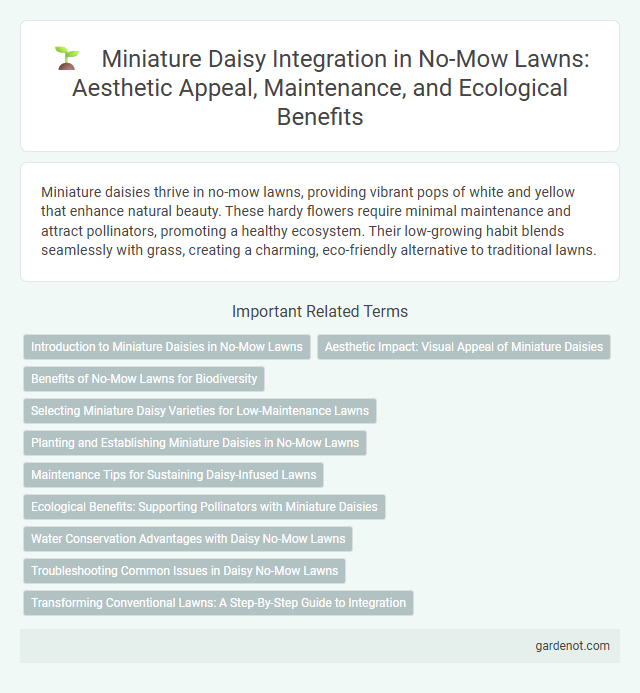Miniature daisies thrive in no-mow lawns, providing vibrant pops of white and yellow that enhance natural beauty. These hardy flowers require minimal maintenance and attract pollinators, promoting a healthy ecosystem. Their low-growing habit blends seamlessly with grass, creating a charming, eco-friendly alternative to traditional lawns.
Introduction to Miniature Daisies in No-Mow Lawns
Miniature daisies (Bellis perennis) thrive in no-mow lawns due to their low growth habit and tolerance for infrequent mowing, creating vibrant, natural ground cover. Their small, hardy blooms provide continuous visual appeal and attract pollinators, enhancing biodiversity in sustainable landscaping. Incorporating miniature daisies reduces lawn maintenance while promoting eco-friendly, pesticide-free gardening practices.
Aesthetic Impact: Visual Appeal of Miniature Daisies
Miniature daisies create a charming no-mow lawn with their dense carpet of small, white blooms highlighted by bright yellow centers, offering continuous color throughout spring and summer. Their low-growing habit and delicate flowers enhance the lawn's visual texture, providing a soft, natural aesthetic that contrasts with traditional turfgrass. This vibrant ground cover requires minimal maintenance while attracting pollinators, adding ecological and visual value to sustainable landscaping.
Benefits of No-Mow Lawns for Biodiversity
Miniature daisies thrive in no-mow lawns, providing essential nectar and pollen that support pollinators such as bees and butterflies. These low-maintenance lawns enhance native plant diversity, creating habitat niches that increase overall ecosystem resilience. By reducing mowing frequency, no-mow lawns promote soil health and carbon sequestration, contributing to sustainable urban biodiversity.
Selecting Miniature Daisy Varieties for Low-Maintenance Lawns
Miniature daisies, such as Bellis perennis varieties, are ideal for no-mow lawns due to their compact size and minimal growth rate. Selecting drought-tolerant and shade-resistant cultivars ensures low-maintenance and year-round greenery with seasonal blooms. Their natural resilience reduces the need for frequent mowing, fertilizing, and watering, making them perfect for eco-friendly, no-mow lawn designs.
Planting and Establishing Miniature Daisies in No-Mow Lawns
Plant miniature daisies (Bellis perennis) in well-drained soil with full sun to partial shade to establish a vibrant no-mow lawn. Space seedlings or seeds about 6-8 inches apart to encourage natural spreading and a dense floral ground cover. Water regularly during the first few weeks to promote strong root development and maintain moisture without waterlogging.
Maintenance Tips for Sustaining Daisy-Infused Lawns
Maintaining a no-mow lawn with miniature daisies involves mowing only once or twice per season to allow flowers to bloom fully and support pollinators. Regularly check soil moisture, aiming for consistent watering without over-saturating, as daisies thrive in well-drained soil. Periodic light fertilization with slow-release organic nutrients enhances flower density and prolongs bloom periods within a sustainable lawn ecosystem.
Ecological Benefits: Supporting Pollinators with Miniature Daisies
Miniature daisies provide essential nectar and pollen resources that support diverse pollinator populations, including bees and butterflies. Their continuous blooming period enhances local biodiversity by sustaining pollinators throughout the growing season. Incorporating miniature daisies into no-mow lawns promotes ecological balance and improves garden health by fostering pollinator habitats.
Water Conservation Advantages with Daisy No-Mow Lawns
Miniature daisies thrive in no-mow lawns, significantly reducing water consumption by requiring minimal irrigation compared to traditional grass. Their deep root systems improve soil moisture retention, enhancing drought resistance and promoting sustainable water use. Integrating miniature daisies into no-mow lawns supports effective water conservation strategies while maintaining attractive ground cover.
Troubleshooting Common Issues in Daisy No-Mow Lawns
Miniature daisies in no-mow lawns often face challenges such as fungal infections caused by excessive moisture and poor air circulation. To troubleshoot, improve soil drainage and avoid overhead watering to reduce leaf wetness, which helps prevent common diseases like powdery mildew. Regularly inspecting plants and removing affected foliage also supports healthier miniature daisy growth in low-maintenance lawn settings.
Transforming Conventional Lawns: A Step-By-Step Guide to Integration
Miniature daisies thrive in no-mow lawn settings by requiring minimal maintenance and offering vibrant ground cover that reduces the need for frequent mowing. Incorporating these flowers involves soil preparation, seed sowing during early spring, and consistent moisture to establish a lush, eco-friendly lawn alternative. Their natural resilience and low growth habit create a sustainable, visually appealing lawn while promoting biodiversity and reducing carbon emissions linked to traditional lawn maintenance.
Miniature daisy Infographic

 gardenot.com
gardenot.com